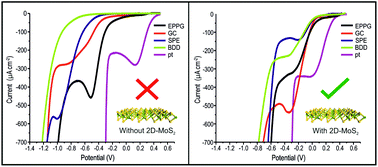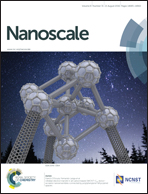2D molybdenum disulphide (2D-MoS2) modified electrodes explored towards the oxygen reduction reaction†
Abstract
Two-dimensional molybdenum disulphide nanosheets (2D-MoS2) have proven to be an effective electrocatalyst, with particular attention being focused on their use towards increasing the efficiency of the reactions associated with hydrogen fuel cells. Whilst the majority of research has focused on the Hydrogen Evolution Reaction (HER), herein we explore the use of 2D-MoS2 as a potential electrocatalyst for the much less researched Oxygen Reduction Reaction (ORR). We stray from literature conventions and perform experiments in 0.1 M H2SO4 acidic electrolyte for the first time, evaluating the electrochemical performance of the ORR with 2D-MoS2 electrically wired/immobilised upon several carbon based electrodes (namely; Boron Doped Diamond (BDD), Edge Plane Pyrolytic Graphite (EPPG), Glassy Carbon (GC) and Screen-Printed Electrodes (SPE)) whilst exploring a range of 2D-MoS2 coverages/masses. Consequently, the findings of this study are highly applicable to real world fuel cell applications. We show that significant improvements in ORR activity can be achieved through the careful selection of the underlying/supporting carbon materials that electrically wire the 2D-MoS2 and utilisation of an optimal mass of 2D-MoS2. The ORR onset is observed to be reduced to ca. +0.10 V for EPPG, GC and SPEs at 2D-MoS2 (1524 ng cm−2 modification), which is far closer to Pt at +0.46 V compared to bare/unmodified EPPG, GC and SPE counterparts. This report is the first to demonstrate such beneficial electrochemical responses in acidic conditions using a 2D-MoS2 based electrocatalyst material on a carbon-based substrate (SPEs in this case). Investigation of the beneficial reaction mechanism reveals the ORR to occur via a 4 electron process in specific conditions; elsewhere a 2 electron process is observed. This work offers valuable insights for those wishing to design, fabricate and/or electrochemically test 2D-nanosheet materials towards the ORR.


 Please wait while we load your content...
Please wait while we load your content...